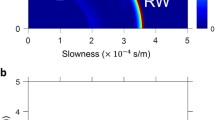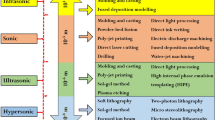Abstract
In pure crystals at low (<1K) temperatures, bulk phonon scattering vanishes, and all scattering takes place at the surface. The fraction of phonons which are diffusely scattered, f, may be substantially reduced by polishing and cleaning. Here, we report measurements of heat conduction in samples with highly polished, specular surfaces (see also Klitsner and Pohl in these Proceedings), and will describe how to obtain f from the measured temperature drop ΔTe between two thermometers clamped to the crystal a distance d apart. A detailed treatment will be presented elsewhere[1]. We define the mean free path (mfp) 1 ≡ 3Q̇/CvA(dT/dx), where Q̇ is the heat input, A is the sample cross-section, v the Debye speed of sound, C the Debye specific heat, x the distance from the top of the sample, and dT/dx is the temperature gradient. Figure 1 shows the data (with dT/dx=ΔTe/d). We see that l-1 depends on the sample length L, and in addition on the size of the clamps used to attach the thermometers to the sample. We will outline how to interpret this remarkable observation, and show that the three curves of Fig. 1 are consistent with nearly the same f once one accounts for the actual temperature profile along the surface of the sample and for the effect of the clamps on the measurement. Previously, CASIMIR[2] considered an infinitely long cylinder with f=1 and found l=2R=lC, where R is the sample radius.
Access this chapter
Tax calculation will be finalised at checkout
Purchases are for personal use only
Similar content being viewed by others
References
J. E. VanCleve, to be published.
H.B.G. Casimir: Physica 5, 495 (1938).
R. Berman, F. E. Simon, and J. M. Ziman: Proc. Roy. Soc. A220, 171 (1953)
R. Berman, E. L. Foster, and J. M. Ziman: Proc. Roy. Soc. A231, 130 (1955).
M. Perlmutter and R. Siegel: J. Heat Transfer 85C, 55 (1963).
A thorough discussion of radiative heat transfer in general is given by M. N. Ozisik: Radiative Transfer (Wiley-Interscience, New York (1973).
Author information
Authors and Affiliations
Editor information
Editors and Affiliations
Rights and permissions
Copyright information
© 1986 Springer-Verlag Berlin Heidelberg
About this paper
Cite this paper
VanCleve, J.E., Klitsner, T., Pohl, R.O. (1986). How Specular are Polished Crystal Surfaces?. In: Anderson, A.C., Wolfe, J.P. (eds) Phonon Scattering in Condensed Matter V. Springer Series in Solid-State Sciences, vol 68. Springer, Berlin, Heidelberg. https://doi.org/10.1007/978-3-642-82912-3_53
Download citation
DOI: https://doi.org/10.1007/978-3-642-82912-3_53
Publisher Name: Springer, Berlin, Heidelberg
Print ISBN: 978-3-642-82914-7
Online ISBN: 978-3-642-82912-3
eBook Packages: Springer Book Archive




